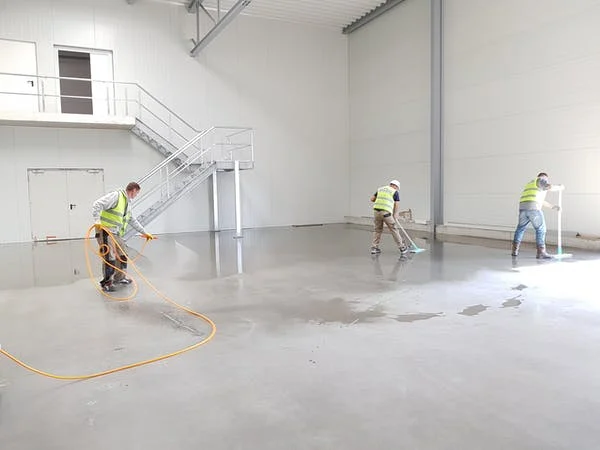What are sealants and coatings for concrete?
Concrete coating is the covering that is applied to cured concrete, usually in the form of a liquid or semi-liquid, for both structural and aesthetic purposes. For example, concrete walls and floors can be given a color and a smoother surface by applying an aesthetically pleasing and protective coating like paint, which also shields the material from abrasion, wear, corrosion, and harsh environmental conditions. A different kind of concrete floor coating can make them more slip-resistant and easier to maintain, or it can shield them from the wear and tear of regular traffic.
Concrete sealers are used to shield the material from stains, corrosion, and surface damage. They either create an impermeable layer that keeps such materials from passing through or they block the pores in the concrete to lessen the absorption of water and salts.
Concrete Coating and Sealing:
Concrete sealer, sometimes referred to as a coat, is a thin or thick layer of protective material that keeps water, dangerous chemicals, gases, and other materials out of the concrete and protects the surface of both new and old concrete from rust, discoloration, and other issues.
Nowadays, dry concrete can be maintained and repaired using concrete sealing and coating to reduce or eliminate water, abrasive solution, or gaseous media penetration.
They are employed to stop deterioration brought on by chemical damage, carbonation, freeze-thaw cycles, and steel corrosion. The materials for coating and sealing are appropriate for sealing cracks and concrete surfaces in generally good condition.
Concrete coatings and sealers
Procedure for Concrete Coating
To apply a gorgeous, well-performing, long-lasting concrete coating, the floor needs to be meticulously prepared. Your coating may begin to deteriorate well in advance of its estimated useful life if a step is skipped.
Floor Preparation-Concrete coatings and sealers
- Shot blasting or diamond grinding
- Grinding
- Tidy Up
- Examination
- Putting on basecoat
- scrubbing
Shot blasting or diamond grinding
One of the two methods used to prepare a surface for concrete coating installation is shot blasting or diamond grinding. Floors with significant divots, intense staining, and other deep blemishes should be shot-blasted. Deep flaws are eliminated by the steel shot, preparing the floor for a fresh coat.
When there are only a few small divots and pits in the floor, diamond grinding is done. This process is less intrusive than shot blasting and opens the pores in the concrete.
Grinding
For your floor, we employ high-quality diamond grinders to help us achieve a robust, long-lasting surface. In order to apply our base coat, we remove the top layer and give it to you!
Tidy up
Following the removal of the uppermost layer by grinding, we ensure that the concrete is prepared for the basecoat by filling any cracks and cleaning any loose concrete.
Examination
Before putting a base coat on your floor, our staff gives the grinding job another look. We want to make sure everything is spotless and prepared for us.

Putting on basecoat
Finally, we use squeegees to evenly apply and spread the polyaspartic base coat that you selected. After that, we try our best to roll up each layer before rolling back down to give your concrete surface an even finish!
Scrubbing
We scrape the floor in two different directions after an hour or two. Any free-standing flakes that were waiting for you are eliminated by doing this! We perform this last vacuum and clean-up before the final topcoat is applied.
How to use a sealer for concrete
For best results, use the appropriate tools to get the ideal sealer thickness and coverage rate. Depending on whether the sealer is solvent- or water-based, the two most popular ways to apply sealers to concrete surfaces are by roller or sprayer. Always follow the specific application instructions provided by the manufacturer.
Always aim for maximum coverage when applying a sealer, whether by rolling or spraying. A gallon of concrete can cover between 250 and 300 square feet, depending on how porous the concrete is.
How much concrete sealer is applied in coats?
Less is more is the most crucial principle to keep in mind. The ideal application method is two light coats, being careful not to let the sealer pool or create thick, uneven patches. To guarantee even coverage, apply the second coat of sealer perpendicular to the first coat or in the opposite direction. Hold off on applying the second coat of sealer for the duration of the manufacturer’s recommended waiting period, usually two to four hours.
Concrete sealer dry time
Always allow the sealer to dry completely before exposing it to foot or vehicle traffic. Drying times before exposure to heavy traffic can be as long as three days.
Advantages of coating or sealing concrete
It lengthens the concrete house’s useful life.
Enhances the house’s appearance.
Increases the home’s value and lessens the likelihood that concrete will spall, flake, or crack.
Offers protection against stains and oil spills.
Fends off mildew
Concrete coatings and sealers-Corporate Clean LLC
The careful preparation, selection, and application of the coating process are critical to the coating’s success. Epoxies, acrylics, vinyl esters, polyurethanes, polyureas, chlorinated rubbers, and elastomeric coatings are a few instances of coating processes. Be cautious when choosing a surface coating because many concrete coatings are unable to seal concrete cracks. Corporate Clean LLC offers the newest coating and sealing options.
Contact US





